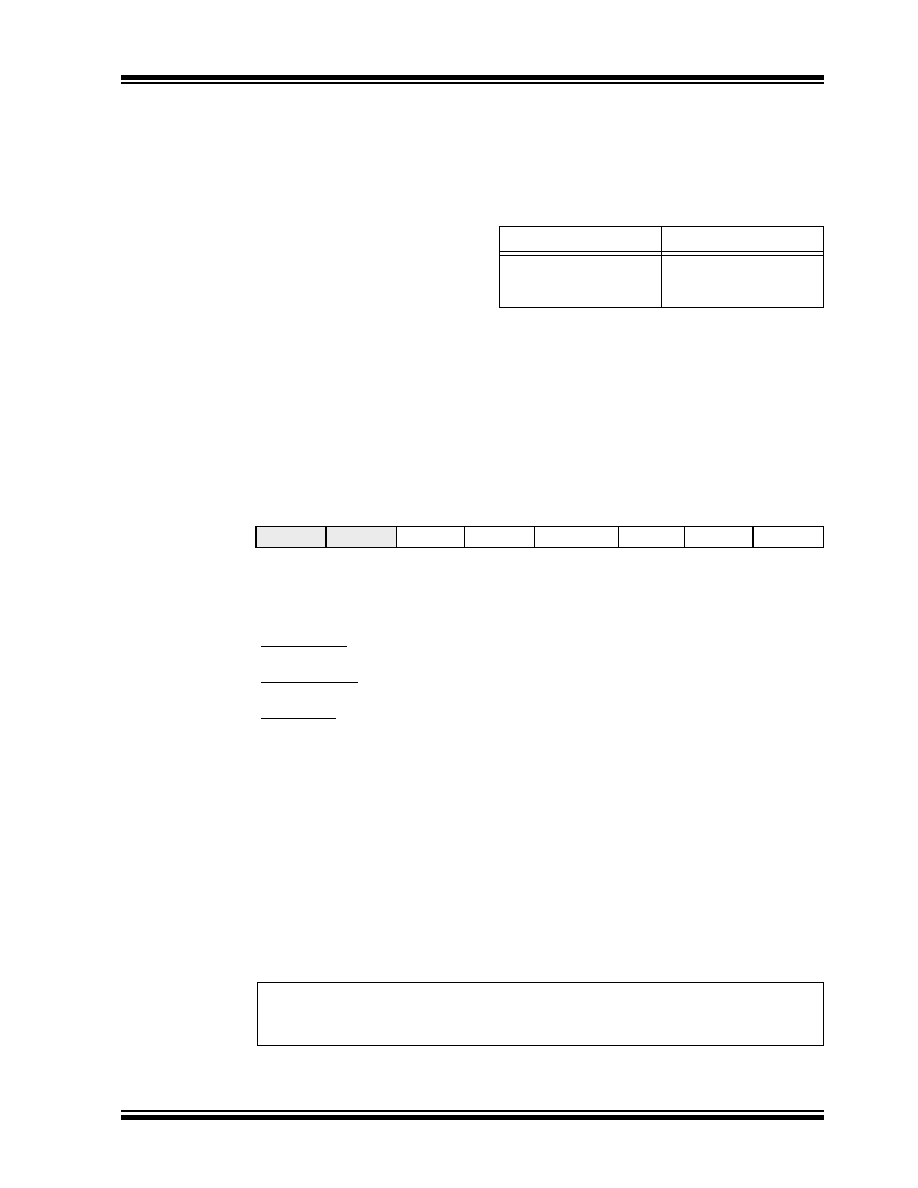- 您现在的位置:买卖IC网 > Sheet目录3887 > PIC16F871-E/L (Microchip Technology)IC MCU CMOS 20MHZ 2K FLSH 44PLCC

2003 Microchip Technology Inc.
DS30569B-page 55
PIC16F870/871
8.0
CAPTURE/COMPARE/PWM
MODULES
Each Capture/Compare/PWM (CCP) module contains
a 16-bit register which can operate as a:
16-bit Capture register
16-bit Compare register
PWM Master/Slave Duty Cycle register
Table 8-1 shows the resources and interactions of the
CCP module. In the following sections, the operation of
a CCP module is described.
8.1
CCP1 Module
Capture/Compare/PWM Register1 (CCPR1) is com-
prised of two 8-bit registers: CCPR1L (low byte) and
CCPR1H (high byte). The CCP1CON register controls
the operation of CCP1. The special event trigger is
generated by a compare match and will reset Timer1
and start an A/D conversion (if the A/D module is
enabled).
Additional information on CCP modules is available in
the PICmicro Mid-Range MCU Family Reference
Manual (DS33023) and in application note AN594,
“Using the CCP Modules” (DS00594).
TABLE 8-1:
CCP MODE - TIMER
RESOURCES REQUIRED
REGISTER 8-1:
CCP1CON REGISTER REGISTER (ADDRESS: 17h/1Dh)
CCP Mode
Timer Resource
Capture
Compare
PWM
Timer1
Timer2
U-0
R/W-0
—
CCP1X
CCP1Y
CCP1M3
CCP1M2 CCP1M1
CCP1M0
bit 7
bit 0
bit 7-6
Unimplemented: Read as '0'
bit 5-4
CCP1X:CCP1Y: PWM Least Significant bits
Capture mode:
Unused
Compare mode:
Unused
PWM mode:
These bits are the two LSbs of the PWM duty cycle. The eight MSbs are found in CCPR1L.
bit 3-0
CCP1M3:CCP1M0: CCP1 Mode Select bits
0000
= Capture/Compare/PWM disabled (resets CCP1 module)
0100
= Capture mode, every falling edge
0101
= Capture mode, every rising edge
0110
= Capture mode, every 4th rising edge
0111
= Capture mode, every 16th rising edge
1000
= Compare mode, set output on match (CCP1IF bit is set)
1001
= Compare mode, clear output on match (CCP1IF bit is set)
1010
= Compare mode, generate software interrupt on match (CCP1IF bit is set, CCP1 pin is
unaffected)
1011
= Compare mode, trigger special event (CCP1IF bit is set, CCP1 pin is unaffected);
CCP1resets TMR1, and starts an A/D conversion (if A/D module is enabled)
11xx
= PWM mode
Legend:
R = Readable bit
W = Writable bit
U = Unimplemented bit, read as ‘0’
- n = Value at POR
‘1’ = Bit is set
‘0’ = Bit is cleared
x = Bit is unknown
发布紧急采购,3分钟左右您将得到回复。
相关PDF资料
PIC16F870T-E/SS
IC MCU CMOS 20MHZ 2K FLSH 28SSOP
PIC16F870T-E/SO
IC MCU CMOS 20MHZ 2K FLSH 28SOIC
PIC16F84AT-20E/SS
IC MCU CMOS 20MHZ 1K FLSH 20SSOP
PIC16F84AT-20E/SO
IC MCU CMOS 20MHZ 1K FLSH 18SOIC
22-15-3133
CONN FFC/FPC 13POS .100 RT ANG
PIC16F84AT-04E/SS
IC MCU CMOS 4MHZ 1K FLASH 20SSOP
22-02-3133
CONN FFC/FPC VERTICAL 13POS .100
PIC16F84AT-04E/SO
IC MCU CMOS 4MHZ 1K FLASH 18SOIC
相关代理商/技术参数
PIC16F871-E/P
功能描述:8位微控制器 -MCU 3.5KB 128 RAM 33 I/O RoHS:否 制造商:Silicon Labs 核心:8051 处理器系列:C8051F39x 数据总线宽度:8 bit 最大时钟频率:50 MHz 程序存储器大小:16 KB 数据 RAM 大小:1 KB 片上 ADC:Yes 工作电源电压:1.8 V to 3.6 V 工作温度范围:- 40 C to + 105 C 封装 / 箱体:QFN-20 安装风格:SMD/SMT
PIC16F871-E/PT
功能描述:8位微控制器 -MCU 3.5KB 128 RAM 33 I/O RoHS:否 制造商:Silicon Labs 核心:8051 处理器系列:C8051F39x 数据总线宽度:8 bit 最大时钟频率:50 MHz 程序存储器大小:16 KB 数据 RAM 大小:1 KB 片上 ADC:Yes 工作电源电压:1.8 V to 3.6 V 工作温度范围:- 40 C to + 105 C 封装 / 箱体:QFN-20 安装风格:SMD/SMT
PIC16F871-I/L
功能描述:8位微控制器 -MCU 3.5KB 128 RAM 33 I/O RoHS:否 制造商:Silicon Labs 核心:8051 处理器系列:C8051F39x 数据总线宽度:8 bit 最大时钟频率:50 MHz 程序存储器大小:16 KB 数据 RAM 大小:1 KB 片上 ADC:Yes 工作电源电压:1.8 V to 3.6 V 工作温度范围:- 40 C to + 105 C 封装 / 箱体:QFN-20 安装风格:SMD/SMT
PIC16F871-I/L
制造商:Microchip Technology Inc 功能描述:8BIT FLASH MCU SMD 16F871 PLCC44
PIC16F871-I/P
功能描述:8位微控制器 -MCU 3.5KB 128 RAM 33 I/O RoHS:否 制造商:Silicon Labs 核心:8051 处理器系列:C8051F39x 数据总线宽度:8 bit 最大时钟频率:50 MHz 程序存储器大小:16 KB 数据 RAM 大小:1 KB 片上 ADC:Yes 工作电源电压:1.8 V to 3.6 V 工作温度范围:- 40 C to + 105 C 封装 / 箱体:QFN-20 安装风格:SMD/SMT
PIC16F871-I/P
制造商:Microchip Technology Inc 功能描述:IC 8BIT FLASH MCU 16F871 DIP40
PIC16F871-I/PT
功能描述:8位微控制器 -MCU 3.5KB 128 RAM 33 I/O RoHS:否 制造商:Silicon Labs 核心:8051 处理器系列:C8051F39x 数据总线宽度:8 bit 最大时钟频率:50 MHz 程序存储器大小:16 KB 数据 RAM 大小:1 KB 片上 ADC:Yes 工作电源电压:1.8 V to 3.6 V 工作温度范围:- 40 C to + 105 C 封装 / 箱体:QFN-20 安装风格:SMD/SMT
PIC16F871-I/PT
制造商:Microchip Technology Inc 功能描述:8BIT FLASH MCU SMD 16F871 TQFP44